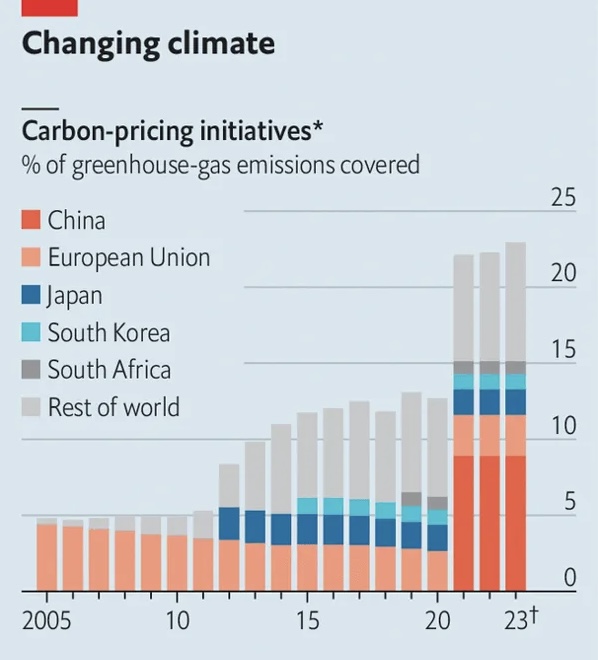Oct 1st 2023
A quarter of global emissions are now covered, and the share is rising fast
Economists have long favoured putting a price on carbon, a mechanism Europe introduced in 2005.
Take Indonesia
On September 26th, at the launch of its first carbon market, Joko Widodo, the president, talked up its prospects as a hub for the carbon trade, and local banks duly snapped up credits from a geothermal-energy firm. The country also introduced an emissions-trading scheme in February, which requires large coal-fired plants to buy permits for emissions above a threshold.
Listen to this story. Enjoy more audio and podcasts on iOS or Android.
If global warming is to be limited, the world must forget fossil fuels as fast as possible—that much almost everyone agrees upon. How to do so is the complicated part. Economists have long favoured putting a price on carbon, a mechanism Europe introduced in 2005. Doing so allows the market to identify the cheapest unit of greenhouse gas to cut, and thus society to fight climate change at the lowest cost. Others, including many American politicians, worry that such schemes will provoke a backlash by raising consumer costs. Under President Joe Biden, America is instead doling out hundreds of billions of dollars to turn supply chains green.
Yet, remarkably, the rest of the world is beginning to look more European—with carbon prices spreading in countries both rich and poor. Take Indonesia, the world’s ninth-biggest polluter. Although it releases 620m tonnes of carbon-dioxide equivalent a year, with almost half its soaring energy consumption coming from coal, the country has green ambitions. On September 26th, at the launch of its first carbon market, Joko Widodo, the president, talked up its prospects as a hub for the carbon trade, and local banks duly snapped up credits from a geothermal-energy firm. The country also introduced an emissions-trading scheme in February, which requires large coal-fired plants to buy permits for emissions above a threshold.
image: the economist
In short, even in countries better known as polluters than green leaders, things are shifting. By the beginning of 2023, 23% of global emissions were covered by a carbon price, up from just 5% in 2010.
According to the imf, 49 countries have carbon-pricing schemes, and another 23 are considering them.

On October 1st the eu launched a groundbreaking policy under a dreary name. The “carbon border adjustment mechanism” (cbam) will, by 2026, start to levy a carbon price on all the bloc’s imports, meaning that European companies will have a strong incentive to push suppliers around the world to go green.

The spread of carbon prices is happening in three ways.
First, governments are creating new markets and levies. Indonesia
Second, countries that already have established markets are beefing up their policies. In September China’s National Climate Strategy Centre announced its emissions-trading scheme, the largest in the world
The final way that carbon markets are spreading is via cross-border schemes. The eu’s programme is by far the most advanced. CBAM.
Many of these schemes will take time to have an impact. Lots in Asia are flimsy, with prices set too low to lead to substantive change—well below the eu’s current price of around €90 ($95), which is itself only approaching climate economists’ estimate of the social cost of carbon.
Industrial firms around the world now face a still greater incentive to accurately track their carbon footprints: cbam. The eu’s ultimate goal is to tackle “carbon leakage”. Before cbam’s introduction, Europe’s carbon price meant that domestic industries faced an extra cost compared with those in countries with less ambitious decarbonisation plans. This gave importers an incentive to source material from abroad, even if such inputs were dirtier. To compensate for this, the eu handed out permits to industrial producers. These will now be phased out as cbam is phased in.
Carbon border tariffs may themselves start to multiply.
There is a domino effect to carbon pricing. Once an industry is subject to a carbon price, affected businesses will naturally want their competitors to face the same rules. Therefore owners of coal power plants will lobby to ensure that gas power plants operate on a level playing field. Governments in exporting countries also have an incentive to ensure that their domestic firms pay a carbon price at home rather than a tariff abroad. If Asia’s factories are pressed to reduce their emissions anyway by schemes such as cbam, then its governments are leaving money on the table by not levying a carbon price of their own.
The question is whether the dominoes will fall sufficiently quickly.
'Economist' 카테고리의 다른 글
| 2023 looks set to be a watershed year for the climate (0) | 2023.10.18 |
|---|---|
| The global backlash against climate policies has begun (0) | 2023.10.13 |
| Claudia Goldin wins the Nobel prize in economics (1) | 2023.10.11 |
| All work and no play : Productivity has grown faster in western Europe (0) | 2023.10.07 |
| 펜타닐과 절망사, 세계화 (0) | 2023.10.04 |